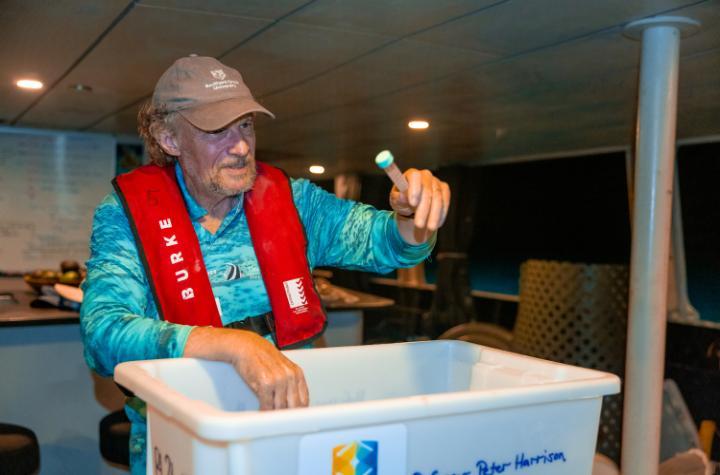Great Barrier Reef’s baby boom holds the key to its protection
Share
/prod01/channel_8/media/scu-dep/news/images/2021/Peter-Harrison-at-Lizard-Island20211122_02-720X475.jpg)
The Great Barrier Reef is booming with new life after the world’s biggest reproductive event – coral spawning – delivered Southern Cross University's Distinguished Professor Peter Harrison a narrow window to help secure its future.
In one of the most extraordinary natural phenomena on the planet, many corals simultaneously reproduce on a few nights each year, releasing enough spawn to produce trillions of baby corals.
This spawning event, happening right now, provides scientists with an opportunity to fast-track world-leading research to help the Great Barrier Reef resist, adapt to and recover from the impacts of climate change.
Minister for the Environment Sussan Ley said: “The Morrison Government’s $150 million Reef Restoration and Adaptation Program includes world leading scientific research into spawning and ‘Coral IVF’ to strengthen and restore reefs.
“This time of year is an exciting one for everyone on the Reef but particularly for our scientists.
“Latest reports on the Reef show that we are seeing strong increases of hard coral cover but there are still significant threats from rising sea temperatures and we are working with the Great Barrier Reef Foundation and Marine Scientists to ensure the resilience of the Reef,” Minister Ley said.
DISTINGUISHED PROFESSOR PETER HARRISON: When we first discovered the mass coral spawning on the Great Barrier Reef 40 years ago we never would have imagined that we would need to put corals back onto the Great Barrier Reef. But what happened since that period is that we've had successive mass coral bleaching events, very large Crown of Thorns starfish outbreaks.
"I can smell it!"
DISTINGUISHED PROFESSOR PETER HARRISON:: And as a result of that we've lost a lot of breeding corals from many different parts of the Reef.
"Yeah."
"Oh look at that."
"That is so cool!"
DISTINGUISHED PROFESSOR PETER HARRISON:: What we're trying to do now is work out how most effectively to use these natural spawning events to grow hundreds of millions of larvae to start the restoration process.
Southern Cross University Distinguished Professor Peter Harrison was part of the small team of researchers to discover mass coral spawning 40 years ago.
He is on Lizard Island, in the far northern section of the Great Barrier Reef, with research partners CSIRO (Australia’s national science agency) and QUT to carry out a novel coral larval restoration technique that he’s spent many years developing and refining.
“We’re excited to be scaling up the coral larval restoration process on the Great Barrier Reef collaborating with research partners at Lizard Island and our aim to optimise large-scale larval production directly on the Reef,” Professor Harrison said.
“We are trialling new methods to capture coral spawn slicks, grow many millions of larvae in different larval culture pools floating in the lagoon at Lizard Island, and then test different methods to deliver and settle healthy larvae onto reef sites damaged by mass bleaching events, which no longer have enough live corals present.
“The timing of these projects coincides with the 40th anniversary of the discovery of the mass coral spawning on the Great Barrier Reef, and that discovery now enables us to efficiently collect coral spawn and culture larvae from many species to scale up coral restoration processes,” Professor Harrison added.

Professor Peter Harrison inspecting a sample of fertilised coral eggs during the spawning at Lizard Island.
Great Barrier Reef Foundation Managing Director Anna Marsden said: “Climate change is the greatest threat to our Reef. In addition to reducing emissions, we need to pioneer new solutions to create a toolbox of techniques that can be used to help protect the reefs we have left, restore lost reefs and help corals adapt to warming ocean temperatures.
“From Lizard Island in the far north to Townsville and Heron Island further south, scientists are busy collecting spawn as part of the world’s largest collaborative effort to protect an ecosystem from climate change, the Reef Restoration and Adaptation Program,” Ms Marsden said.
CSIRO Senior Research Scientist Dr Christopher Doropoulos is leading the research on Heron Island, off Gladstone.
“Research on coral spawning plays an important role in aiding innovative approaches to help restore damaged parts of the Reef. Understanding how coral responds to different interactions and disturbances during all stages, from coral reproduction to coral larvae development and settlement, is helping us predict and test coral recovery at larger scales,” said Dr Doropoulos.
“Our trials at Heron Island have been really promising so far and we are now testing and optimising some of these methods at Lizard Island to help scale-up restoration efforts for larger areas of the Reef that need it.”
Australian Institute of Marine Science Principal Research Scientist Dr Line Bay, a leading researcher in the program, is overseeing the coral spawning research underway in the National Sea Simulator.
“Our science teams have collected hundreds of parent colonies from across the Great Barrier Reef to breed in the National Sea Simulator – and this year we’re expecting close to 50 million baby corals,” Dr Bay said.
“Breeding corals during spawning allows us to fast-track our understanding on how we can enhance coral survival and growth and help corals better cope with increased seawater temperatures. We do this both in the lab and out on the Reef.
"By perfecting and scaling up these techniques, we hope to increase the number of ‘captive-born’ heat-tolerant young corals, and potentially release these onto large areas of degraded reefs in the future."
This research is part of the Reef Restoration and Adaptation Program which is funded by the partnership between the Australian Government’s Reef Trust and the Great Barrier Reef Foundation. Partners include the Australian Institute of Marine Science, Great Barrier Reef Foundation, CSIRO, The University of Queensland, QUT, Southern Cross University and James Cook University.
Media contact: Sharlene King, media office at Southern Cross University, 0429 661 349 or scumedia@scu.edu.au

/prod01/channel_8/media/scu-dep/current-students/images/Coffs-harbour_student-group_20220616_33-147kb.jpg)
/prod01/channel_8/media/scu-dep/current-students/services/counselling/images/RS21533_English-College-Student_20191210_DSC_6961-117kb.jpg)
/prod01/channel_8/media/scu-dep/study/scholarships/images/STEPHANIE-PORTO-108-2-169kb.jpg)
/prod01/channel_8/media/scu-dep/study/arts-and-humanities/images/RS20958_Chin-Yung-Pang-Andy_20190309__79I5562-960X540.jpg)
/prod01/channel_8/media/scu-dep/experience/images/SCU-INTNL-STUDY-GUIDE-280422-256-72kb.jpg)
/prod01/channel_8/media/dep-site-assets/component-library/screenshots/online-1X1.jpg)
/514x0:1487x973/prod01/channel_8/media/scu-dep/news/images/2025/Freckles-moles-sunspots_credit-Cottonbro-on-Pexels-2000X973.jpg)
/514x0:1487x973/prod01/channel_8/media/scu-dep/news/images/2025/Books-textbooks-library_credit-Pixabay-on-Pexels-2000X973.jpg)
/250x0:1250x1000/prod01/channel_8/media/scu-dep/news/images/Todd_Thimios_Cocos_Island_Ultimate_Dive_Sites.jpg)
/514x0:1487x973/prod01/channel_8/media/scu-dep/news/images/2025/Donald-Trump_credit-Library-of-Congress-on-Unsplash-2000X973.jpg)
/511x0:1490x979/prod01/channel_8/media/scu-dep/news/images/2025/Childs-diagram-of-Lismore-floods-from-The-Floods-and-Me-project-2000X973.jpg)
/514x0:1487x973/prod01/channel_8/media/scu-dep/news/images/2025/Luxury-accommodation-at-Springbook-Qld_credit-Josh-Withers-on-Unsplash-2000X973.jpg)
/504x0:3528x3024/prod01/channel_8/media/scu-dep/news/images/2022/IMG_4668.jpeg)
/514x0:1487x973/prod01/channel_8/media/scu-dep/news/images/2025/Humpback-whale_credit-Aurore-Murguet-on-Pexels-2000X973.jpg)
/514x0:1486x972/prod01/channel_8/media/scu-dep/news/images/2025/Girl-holding-plush-toy_credit-Pixabay-on-Pexels-2000X973.jpg)
/514x0:1487x973/prod01/channel_8/media/scu-dep/news/images/2025/Ramadan-food-nuts-and-dates_credit-Anntarazevich-on-Pexels-2000X973.jpg)